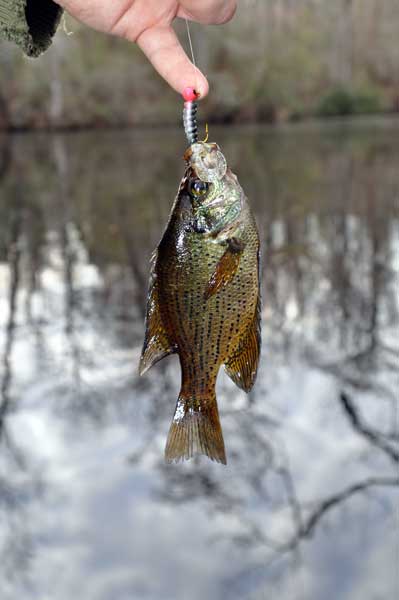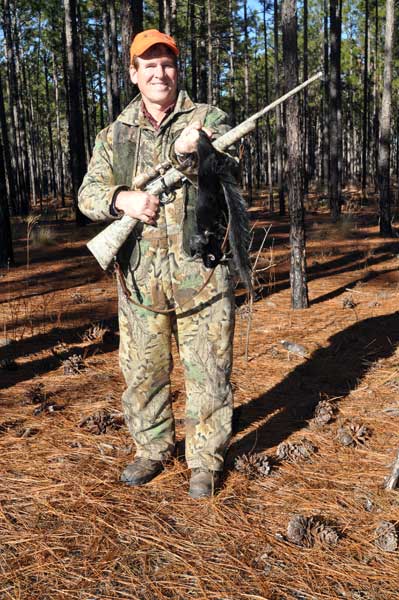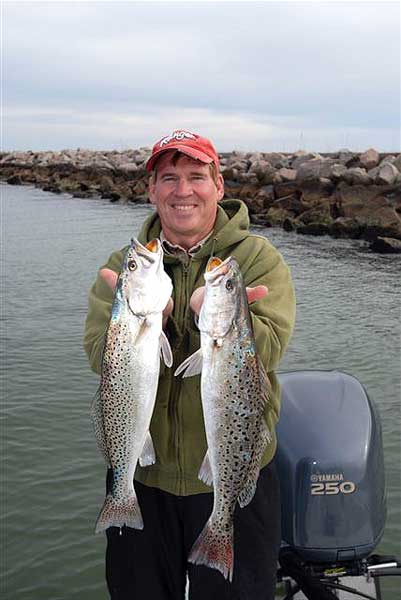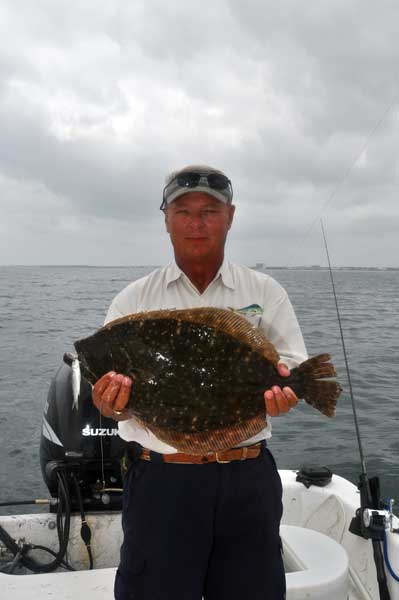- Details
- Written by Mike Marsh
I don't know if it was the new moon or the sudden drop in temperature from our first big rain in quite a while. But the inshore and offshore flounder bite has been Fintastic! The best bait has been live mullet. But the fish are also striking live menhaden and jigs.
I fished with Dennis Barbour at the reefs and ledges and we caught 19 flounder and kept 19 with the two top fish weighing 4.9 and 5.3 pounds. The next day, I fished the Cape Fear River and the biggest fish I netted weighed 5 pounds, 12 ounces. Landing a fish that size alone gets quite thrilling in all of the current, with the rod in one hand and the net in the other.
Over all of the years I've been fishing the southern coast of North Carolina, the third week of August has been the epicenter of activity for big flounder. The number of citation fish weighing more than 5 pounds typically peaks that week. But during hurricane season, weather can keep anglers from fishing. We're keeping a wary eye on Emily at this moment. We need the rain, but can do without the wind!
Dennis Barbour of Island Tackle Charters caught this 5.3-pound flounder fishing offshore of Carolina Beach, one of 19 flounder we landed that day. Ten fish were keepers.
Mike Marsh
- Details
- Written by Mike Marsh
 It's been so hot and windy, with winds blowing up to 25 mph out of the southwest, that I headed inland to fish. I made a trip to the Roanoke, Middle and Cashie rivers with Bob Smithwick, a world class bluegill fisherman who ties his own flies. We used a foam bodied popper and Tail-End-Charlie to catch at least 60 fish. We probably would have caught 100 to 200 before 10 a.m. if I hadn't been working the camera. The fish are everywhere along the banks and the big cypress and black gum trees provide plenty of shade.
It's been so hot and windy, with winds blowing up to 25 mph out of the southwest, that I headed inland to fish. I made a trip to the Roanoke, Middle and Cashie rivers with Bob Smithwick, a world class bluegill fisherman who ties his own flies. We used a foam bodied popper and Tail-End-Charlie to catch at least 60 fish. We probably would have caught 100 to 200 before 10 a.m. if I hadn't been working the camera. The fish are everywhere along the banks and the big cypress and black gum trees provide plenty of shade.
- Details
- Written by Mike Marsh
 The CCA-NC (Coastal Conservation Association of North Carolina ) reports that N.C. House Bill 353, which seeks game fish status for Red Drum, Speckled Trout, and Striped Bass has generated more than 24,000 emails in support of the measure to the members of the House Commerce and Job Development Committee. Prompting the measure have been abuses by the commercial fishing sector, through violations of bycatch regulations regarding red drum landings two winters in the past, and more recently, several striped bass "spills" that legally killed "bycatch" thousands of striped bass over a 50-fish commercial landing limit, that fired outrage throughout the recreational fishing community. The N.C. Division of Marine Fisheries has taken steps to minimize the damage to striped bass, for example by allowing other commercial fishing boats to share any catch by another commercial fishing boat that nets more than the 50-fish limit.
The CCA-NC (Coastal Conservation Association of North Carolina ) reports that N.C. House Bill 353, which seeks game fish status for Red Drum, Speckled Trout, and Striped Bass has generated more than 24,000 emails in support of the measure to the members of the House Commerce and Job Development Committee. Prompting the measure have been abuses by the commercial fishing sector, through violations of bycatch regulations regarding red drum landings two winters in the past, and more recently, several striped bass "spills" that legally killed "bycatch" thousands of striped bass over a 50-fish commercial landing limit, that fired outrage throughout the recreational fishing community. The N.C. Division of Marine Fisheries has taken steps to minimize the damage to striped bass, for example by allowing other commercial fishing boats to share any catch by another commercial fishing boat that nets more than the 50-fish limit.
The striped bass game fish status has been sought for many years and started primarily in the Northeast, where anglers depend more on striped bass for sport than in the mid-Atlantic and South-Atlantic states. However, with the restoration of the more southern striped bass populations has come more intense fishing pressure, by both the recreational and commercial fishing communities.
"Game Fish" designation goes against North Carolina's established marine fisheries doctrine and law, which requires an equitable distribution of marine fish and finfish resources among user groups on a historical catch basis. Currently, the only way to create larger catches in any sector is to increase the size of the fisheries "pie" so everyone is able to catch more fish, at the same ratio as in the past. Conversely, when the population falls, the slice of the pie is smaller, or non-existent, for each user group.
But now, with closed seasons, falling catch limits, increasing size limits and everyone wanting to be able to keep fishing, along with the re-interpretation (and a more strict interpretation) of the Federal fisheries law, it's come to a showdown, a them-verses-us fight between North Carolina's commercial fishermen and recreational fishermen.
Based on the history of land-based wildlife resources and inland-based fisheries resources, few species that have been commercially exploited have been able to survive that exploitation, being nearly depleted to extinction until brought back by recreational and conservation programs as commercially viable populations of that wildlife or fish were killed off. Some species are extinct or have never returned to any huntable or fishable population. It's exactly what is happening now in the ocean, to North Carolina's finfish resources.
We are going to have to get used to closures and tighter landings limits, as have been the case with wildfowl and game mammals for nearly a century. Just because you spend tens of thousands of dollars on a duck boat, decoys, shotguns, travel and hunting leases, or on boats, rigs, rods and tackle, doesn't mean you deserve a larger share than anyone else of ducks, geese, marlin or flounder. The bag limit is the bag limit.
But wild animals and freshwater fish were "saved" not only by banning commercialization (with the exceptions of furbearers and some finfish such as catfish that can be managed for commercial harvest), but by commercial farming operations that replaced ducks and geese with domestic turkeys and chickens, deer and elk venison with beef. As commercial fishing becomes less economically viable, aquaculture operations become more economically viable. The balance tips more in favor of aquaculture, and less toward commercial fishing every day. It's really simple economics. Lets hope the crisis of near extinction that occurred within the U.S. internal landmass can be averted in the U.S. waters of the Atlantic Ocean. Sooner or later, game fish status is in store for certain finfish species, if not all finfish species because commercially viable numbers will cease to exist.
p>
Some blame gear, such as gill nets or trawls, for problems with fisheries. They can call it bycatch problems or over-harvest of target fish, but it's really all the same situation. Over the long haul, I predict that these problems will continue occurring with any species of fish that can be sold commercially. No animal with a price on its head has been able to survive in thriving numbers - a look back in history bears out this simple fact. But, until a replacement source of seafood is available, such as farm-raised fish and shellfish, in adequate supply to fill demand, commercial fishing is going to continue in the ocean.
Now is a good time to start with game fish status for some species - and eventually for all species. I predict that this will happen and has to happen as the world's population continues to demand more and more of the ocean's resources. These finfish species in the game fish bill have faced and will continue to face crises of near-extinction, as long as they are exploited commercially. Recreational demand can be controlled. Commercial demand cannot.
Support NCHB 353.
Mike
- Details
- Written by Mike Marsh
 With the water temperatures rising, we decided to try catching black crappie. While white crappie are introduced fish, black crappie are indigenous to North Carolina’s coastal rivers.
With the water temperatures rising, we decided to try catching black crappie. While white crappie are introduced fish, black crappie are indigenous to North Carolina’s coastal rivers.
My son, Justin, wanted to head to a lake so we picked Columbus County’s Lake Waccamaw. To hedge our bets, we arrived loaded for white perch, with several trolling rods rigged with Rat-L-Traps and Shad-Raps.
The day started with a fresh, easterly wind. So we first headed for the lake’s dam at the southwest corner. The Waccamaw River was nearly flooding over the top of the spillway and the fishing was tough, according to an old-timer who told us only a few yellow perch had been caught.
So, instead of beating the bank, we launched the 16-foot johnboat at the NCWRC ramp after the wind died. We trolled the sloping areas and beside no-wake pilings. We cast twisty-tailed grubs beneath boat docks. We searched for any type of structure that might hold fish using a side-scan sonar feature on a Fishing Buddy depthfinder. But it was all to no avail.
The wind started blowing again, so we headed for sheltered waters in Big Creek. The creek is essentially a dugout channel with steep sides covered by overhanging trees, making it perfect crappie cover.
Nevertheless, we still cast fruitlessly, snagging overhanging limbs with our lines. Eventually we found ourselves blocked from further access to upstream waters by a new bridge. It appeared the new highway bridge was lower than the former bridge. However, upon closer inspection we found we could just clear it by lying in the bottom of the boat and sitting far enough forward for the outboard motor’s cowl to clear concrete. Turned out, the problem was not the bridge’s height, but the height of water rushing beneath it from recent rain.
“Don’t crappie like bridges?” Justin asked. “Do you think we should try our luck here?”
Proving he was a chip off the old block by asking that particular question, he dropped the trolling motor and we began casting around the pilings. He used a Beetlespin, while I cast a small jig with a blue grub tail.
“There’s a fish,” he said. “It felt like a crappie flicking it.”
A couple of casts later and we still had only a “skunk” in our ice chest, rather than a crappie. We could see fish swirling the surface in the shadow of the bridge, but couldn’t seem to get a hook into one of them.
I began using the “secret” retrieve, typically reserved for short-striking crappie, giving a tiny twitch of the rod during every turn of the reel handle. I also snipped off the nose of a grub so it would slide it forward on the jig, making the hook point protrude closer to the tail.
On the second cast using this refined retrieve, a fish bit the lure and I set the hook. Reeling the fish to the boat, I expected to see a black crappie. It took a few seconds to decide it was not a crappie at all, but a flier.
Many novice anglers mistake a flier for a crappie. However, the darker sides and the asymmetrical eye pupil are dead giveaways the fish is a flier. No one knows why the flier is called that particular name. It could be because the fish has a generous supply of fins around its perimeter so appears to be able to fly through the water. The fish doesn’t jump, so it’s aerial abilities do not account for the moniker. Some fishermen compare the fight of a flier to the sensation of reeling in a sopping wet leaf. The flier turns onto its side and is easy to skip along the surface all the way to the boat. Perhaps an angler making the fish “fly” across the top gave the its name.
But a flier by any other name would still taste as sweet. We caught some fliers and while they weren’t the crappie or white perch we came after, no one can tell the difference when they are headed and scaled and set on a plate, hot from a frying pan.
- Details
- Written by Mike Marsh
 January Doves are challenging to hunt. It's hard to down a limit of 15 doves. But it helps if you can find a concentration of doves in a clear-cut, pasture or soybean field. Clear cuts are excellent places as are stands of scrub oaks and power line rights-of-way. Sometimes large harvested corn or soybean fields hold large flocks of doves that won't break up. When that occurs, using a Mojo or other spinning wing decoy is a good bet. A flock of stationary doves sitting on the ground beside it or some sort of telescoping pole that doves decoys can be set upon for some elevation will turn the trick. Outwitting a few winter doves using decoys can be as exciting as a duck hunt.
January Doves are challenging to hunt. It's hard to down a limit of 15 doves. But it helps if you can find a concentration of doves in a clear-cut, pasture or soybean field. Clear cuts are excellent places as are stands of scrub oaks and power line rights-of-way. Sometimes large harvested corn or soybean fields hold large flocks of doves that won't break up. When that occurs, using a Mojo or other spinning wing decoy is a good bet. A flock of stationary doves sitting on the ground beside it or some sort of telescoping pole that doves decoys can be set upon for some elevation will turn the trick. Outwitting a few winter doves using decoys can be as exciting as a duck hunt.
- Details
- Written by Mike Marsh
 Editor's Note: Mike Marsh took this black phase fox squirrel at Bladen Lakes Game Land at 12:30 p.m. Fox squirrels move throughout the day and are typically more active in late morning and early afternoon that gray squirrels. The rifle is a Savage M93 in camo finish with AccuTrigger. It is extremely accurate. The bullet was a Winchester 20 grain game bullet. Although it is a better choice for shooting squirrels with less destruction than the polymer tipped .17HMR ammo, the longer ogive and dimple point causes occasional feeding problems when the edge of the point strikes the lower part of the chamber in both of my .17 HMR rifles. Bending the ears on the magazines and bending the magazine catches has improved, but not eliminated these problems. An idea for rifles that don't feed the 20 grainers reliably is loading the Game Bullet first, then following with the .17-grain polymer tips in the magazine. My rifles shoot some brands to identical points of impact.
Editor's Note: Mike Marsh took this black phase fox squirrel at Bladen Lakes Game Land at 12:30 p.m. Fox squirrels move throughout the day and are typically more active in late morning and early afternoon that gray squirrels. The rifle is a Savage M93 in camo finish with AccuTrigger. It is extremely accurate. The bullet was a Winchester 20 grain game bullet. Although it is a better choice for shooting squirrels with less destruction than the polymer tipped .17HMR ammo, the longer ogive and dimple point causes occasional feeding problems when the edge of the point strikes the lower part of the chamber in both of my .17 HMR rifles. Bending the ears on the magazines and bending the magazine catches has improved, but not eliminated these problems. An idea for rifles that don't feed the 20 grainers reliably is loading the Game Bullet first, then following with the .17-grain polymer tips in the magazine. My rifles shoot some brands to identical points of impact.
I've hunted fox squirrels for years. I once shot a silver phase fox squirrel back when Sutton Lake game land still had longleaf pines and the fox squirrels were abundant. Now, the area has been logged and is no longer a game land, except around the fringes of the lake with a bow-only area south of the power plant.
The black phase is not really rare, but they are less common than other phases.
I was hunting at Bladen Lakes State Forest, but other game lands that have them include Croatan and Sandhills. I don't know why the SC WMA's don't allow hunting fox squirrels, but I have seen many black phase fox squirrels there. Pee Dee NWR does not allow them to be hunted, but I have see them there as well.
A friend mounted the silver fox squirrel years ago. It was all silver and had blue eyes and I have never seen another one. I wonder if it had grown so old that it had simply "gone gray" from its former coloration.
My black phase fox squirrel was a female and I will have her mounted. I had been speaking to Andy Waldrop, the local NCWRC officer for about an hour. I headed for an area that has traditionally had lots of fox squirrel nests and watched them. While I have taken many gray phase fox squirrels, I had not seen a black phase in this area.
I sat on folding chair for less than five minutes, looking at a limb that seemed perfect for sunning on a chilly day. A dark shadow slunk along below some live oak leaves, making its way to the sunning limb.
It was a black phase fox squirrel!
I aligned the crosshairs of a 3x9x32 Simmons .22 MAG scope. With its adjustable objective and ocular, the sight image was so clear I could see individual hairs at 50 yards. The shot seemed too easy for a hunt that took years to complete.
I suggest that anyone who wants to take a black phase fox squirrel NOT shoot the other color phases during a hunt. The limit of one per day surely delayed my taking of the black phase. But for me, any shot at a fox squirrel had been just too tempting to pass up. It typically takes two days of hunting to get a shot at a fox squirrel in good habitat. Go deer hunting and they appear as common as flies. Go fox squirrel hunting, and they seem to disappear.
- Details
- Written by Mike Marsh
 The big speckled trout have arrived with the cold. All of the inlets are loaded with big specks.The best bait is live shrimp. If you can't catch live shrimp, try a mud minnow or mullet. Many places have live shrimp for sale for about $6 a dozen. You can go through a lot of shrimp so buy several dozen to feed the bluefish and pigfish along with the specks.
The big speckled trout have arrived with the cold. All of the inlets are loaded with big specks.The best bait is live shrimp. If you can't catch live shrimp, try a mud minnow or mullet. Many places have live shrimp for sale for about $6 a dozen. You can go through a lot of shrimp so buy several dozen to feed the bluefish and pigfish along with the specks.
Best inlets are Masonboro, Topsail, Beaufort and all the areas at the Cape Fear River mouth. Find the rocks and other hard structure such as seawalls, oyster beds and pilings in deeper water and you will find the specks.
A great new lure is the Berkley Gulp Ripple Mullet. Use a color that has the green tail. These lures have better action that the older style BG lures with the exception of the Goby. But the Ripple Mullet has a more durable tail than the Goby.
The fact that anglers can buy live shrimp and use these excellent new scented lures is one of the main reasons the NCDMF has increased the length limit for specks to 14 inches and reduced the bag limit to six fish. Recreational anglers who don't know how to catch live shrimp for winter fishing can now get in on the action.
I remember when only a couple of anglers ever fished through the winter. Now, few anglers "winterize their boats. Instead, they continue fishing for specks until the water gets down into the 40s.
Copyright Notice
Any use of images and/or content of this website without a license agreement issued by Michael S. Marsh is strictly prohibited.

